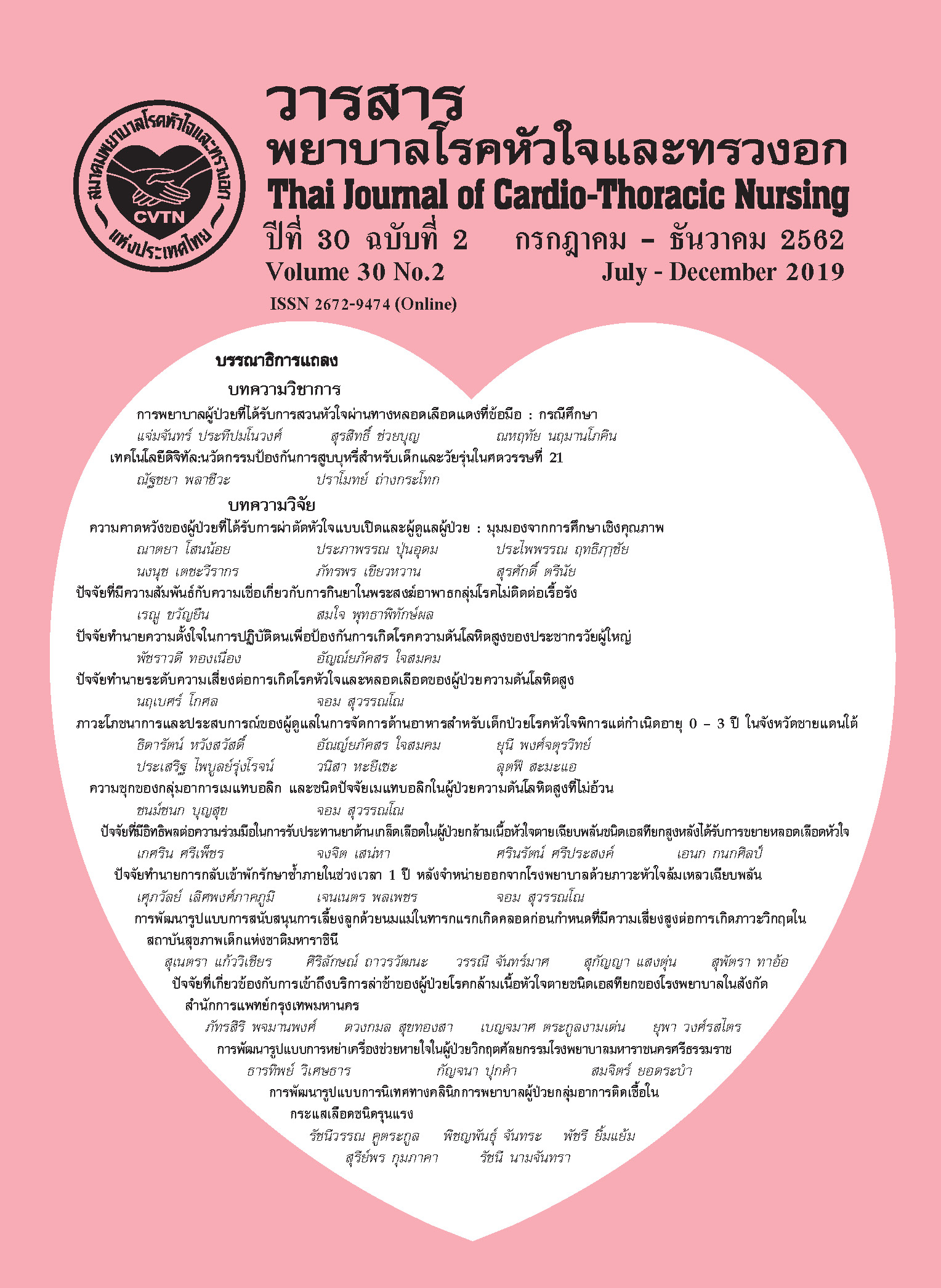เทคโนโลยีดิจิทัล: นวัตกรรมป้องกันการสูบบุหรี่สำหรับเด็กและวัยรุ่น ในศตวรรษที่ 21
คำสำคัญ:
เทคโนโลยีดิจิทัล, การสูบบุหรี่, การป้องกัน, วัยรุ่น, เด็กบทคัดย่อ
การสูบบุหรี่ของประชากรวัยเด็กและวัยรุ่นเป็นปัญหาสาธารณสุขที่สำคัญในทุกประเทศทั่วโลก ควันสูบบุหรี่เป็นสาเหตุที่ก่อให้เกิดปัญหาสุขภาพหลายชนิดโดยเฉพาะการเกิดหอบหืดที่รุนแรงและบ่อยครั้ง โรคติดเชื้อทางเดินหายใจและโรคปอดเรื้อรัง ปัจจุบันมีการนำเทคโนโลยีดิจิทัลมาบูรณาการกับกระบวนการทำงานของพยาบาลวิชาชีพเพิ่มมากขึ้น ซึ่งส่งผลให้การส่งเสริม ป้องกัน และปรับเปลี่ยนพฤติกรรมเสี่ยงด้านสุขภาพในวัยรุ่นมีประสิทธิผลมากขึ้น บทความนี้มีวัตถุประสงค์เพื่อนำเสนอนวัตกรรมป้องกันการสูบบุหรี่สำหรับเด็กและวัยรุ่นที่บูรณาการแบบแผนความเชื่อด้านสุขภาพ ทฤษฎีการกระทำด้วยเหตุผล ทฤษฎีการเรียนรู้ทางปัญญาสังคม และแบบแผนการประมวลสารสนเทศ บทความนี้สามารถเสนอแนะแนวทางในการพัฒนานวัตกรรมในการขับเคลื่อนกระบวนการป้องกันการสูบบุหรี่ในกลุ่มเด็กและวัยรุ่นบนพื้นฐานของเทคโนโลยีดิจิทัลที่มีประสิทธิภาพและเหมาะสมสำหรับพลเมืองยุคดิจิทัลต่อไป
เอกสารอ้างอิง
Center for Behavioral Health Statistics and Quality. 2015 national survey on drug use and health: detailed tables. Rockville, Maryland: Substance Abuse and Mental Health Services Administration; 2016.
Centers for Disease Control and Prevention. Sustaining state programs for tobacco control: state data highlights. Atlanta: Office on Smoking and Health; 2008.
U.S. Department of Health and Human Services. The health consequences of smoking-50 years of progress: a report of the surgeon general. Washington: Office of the Surgeon General, U.S. Department of Health and Human Services; 2014.
American Lung Association. Tobacco use among children and teens. Chicago: American Lung Association's National Office; 2019.
Sirirassamee B, Sirirassamee T, Jampaklay A, Holumyong C, Konkaew T. Effects of tobacco control policies among Thai adolescents wave 6 (2012). Nakhon Pathom: Institute for Population and Social Research, Mahidol University; 2014. (in Thai).
Thangkratok P, Chaimo E, Yingyoud P, Trainattawan W. Prevalence of tobacco smoking among nursing students: a systematic review. Journal of Health Science. 2019;28(4):601-9. (in Thai).
Wood L, Greenhalgh EM, Vittiglia A, Hanley-Jones S. Factors influencing uptake by young people: overview. Melbourne: Cancer Council Victoria; 2019.
Palmerini C, Saccardi C, Ferracci F, Arienti S. Lipid patterns in the saliva of smoking young adults. Hum Exp Toxicol. 2011;30(10):1482-8.
Fernandes SdSC, Andrade CRd, Caminhas AP, Camargos PAM, Ibiapina CdC. Prevalence of self-reported smoking experimentation in adolescents with asthma or allergic rhinitis. J Bras Pneumol. 2016;42(2):84-7.
Park S-H. Smoking and adolescent health. Korean J Pediatr. 2011;54(10):401-4.
Moylan S, Gustavson K, Karevold E, Øverland S, Jacka FN, Pasco JA, et al. The impact of smoking in adolescence on early adult anxiety symptoms and the relationship between infant vulnerability factors for anxiety and early adult anxiety symptoms: the TOPP Study. PloS one. 2013;8(5):e63252-e.
National Center for Chronic Disease Prevention and Health Promotion (U.S.) Office on Smoking and Health. Preventing tobacco use among youth and young adults: A report of the Surgeon General. Atlanta, GA: CDC; 2012.
Villanti A, Boulay M, Juon HS. Peer, parent, and media influences on adolescent smoking by developmental stage. Addict Behav. 2011;36:133-6.
Mayhew KP, Flay BR, Mott JA. Stages in the development of adolescent smoking. Drug Alcohol Depend. 2000;59 Suppl 1:S61-81.
Homsin P. Concepts and theories for practice: smoking and alcohol drinking prevention among adolescents. Chonburi: Chonburi Printing; 2015. (in Thai).
Thangkratok P, Langputeh A, Boonpradit P, Taiwong A, Chaimo E. Psychometric testing of the smoking cessation counseling scale among Thai registered nurses. Journal of The Royal Thai Army Nurses. 2018;19:50-8. (in Thai).
Nadasan V, Chirvasuta R, Abram Z, Mihaicuta S. Types of interventions for smoking prevention and cessation in children and adolescents. Pneumologia. 2015;64(3):58-62.
Park E, Drake E. Systematic review: internet-based program for youth smoking prevention and cessation. J Nurs Scholarsh. 2015;47(1):43-50.
Madden M, Lenhart A, Duggan M, Cortesi S, Gasser U. Pew research internet project. Washington, DC: Pew; 2013.
Crutzen R, de Nooijer J, Brouwer W, Oenema A, Brug J, de Vries NK. Strategies to facilitate exposure to internet-delivered health behavior change interventions aimed at adolescents or young adults: a systematic review. Health Educ Behav. 2011;38(1):49-62.
Palacheewa N, Tiansawad S, Srisuphan W, Whattananarong K, Duffy SA. Development of an internet-based smoking prevention program for young male adolescents in Thailand. Pacific Rim Int J Nurs Res. 2014;18(3):228-43.
Harvey J, Chadi N. Strategies to promote smoking cessation among adolescents. Paediatr Child Health. 2016;21(4):201-8.
Janz NK, Becker MH. The Health Belief Model: a decade later. Health Educ Q. 1984;11(1):1-47
Fishbein M, Ajzen I, Flanders NA. Belief, attitude, intention, and behavior: an introduction to theory and research. Massachusetts: Addison-Wesley; 1975.
Bandura A. Self-efficacy: toward a unifying theory of behavioral change. Psychol Rev. 1977;84(2):191-215.
Alessi SM, Trollip SR. Computer-based instruction: method and development. New Jersey: Prentice Hall; 1991.
World Health Organization. WHO framework convention on tobacco control. Geneva, Switzerland: WHO Press; 2005.
Thangkratok P, Cheevakasemsook A, Angsuchoti S. Digital competency of Thai professional nurses. Journal of Nursing Science & Health. 2019;42:1-12. (in Thai).
ดาวน์โหลด
เผยแพร่แล้ว
รูปแบบการอ้างอิง
ฉบับ
ประเภทบทความ
สัญญาอนุญาต
บทความนี้ยังไม่เคยตีพิมพ์หรืออยู่ในระหว่างส่งไปตีพิมพ์ในวารสารอื่น ๆ มาก่อน และกองบรรณาธิการขอสงวนสิทธิ์ในการตรวจทาน และแก้ไขต้นฉบับตามเกณฑ์ของวารสาร ในกรณีที่เรื่องของท่านได้ได้รับการตีพิมพ์ในวารสารฉบับนี้ถือว่าเป็น ลิขสิทธิ์ของวารสารพยาบาลโรคหัวใจและทรวงอก






